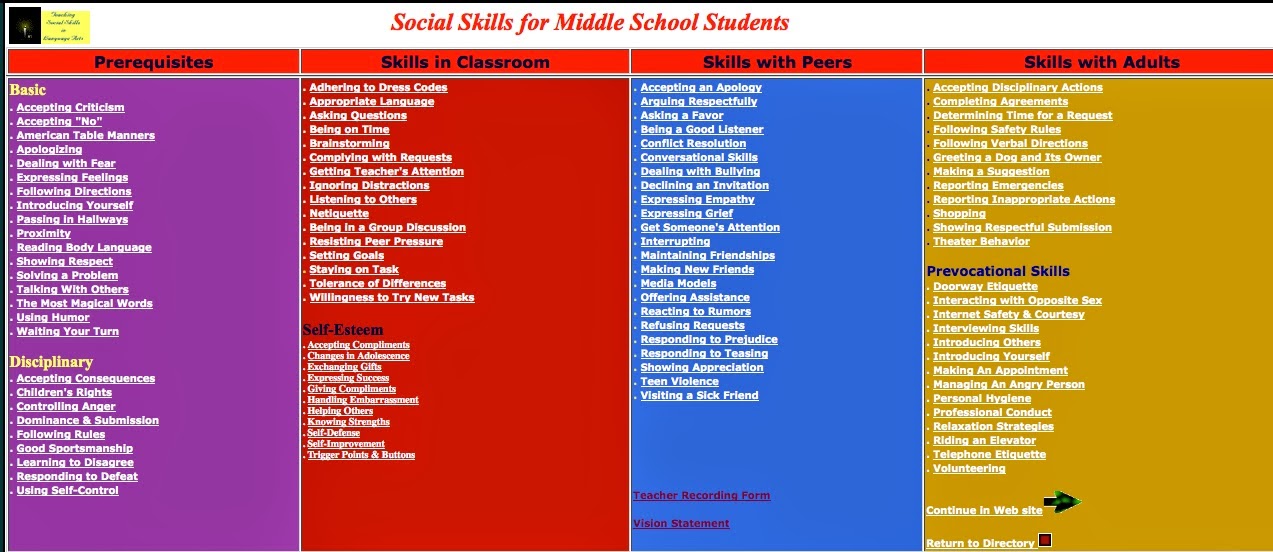Great Book for some discussion - It starts with an illustration of what if ONE person did something like .
. . “spill tacks” . . . and the following page illustrates what would
happen if EVERYone spilled tacks. The book goes through funny actions,
serious actions, and typical parent concerns like: jumping in the mud.
Wednesday, December 30, 2015
Saturday, December 19, 2015
Saturday, December 5, 2015
Saturday, October 31, 2015
Sunday, September 6, 2015
Sunday, August 30, 2015
Would You Rather . . . ?
Love posing these ideas and hearing the discussion . . .
- Would you rather be a pencil or a rubberband?
- Would you rather be a good athlete or a good student?
- Would you rather be able to fly or turn invisible?
- Would you rather have someone give you $100 or give $1,000 to the charity of your choice?
- Would you rather have parents who loved you but were poor or have parents who did not love you but were rich and gave you everything you wanted?
-
Saturday, August 22, 2015
50 Great Advisory Ideas . . .
I love lists that I can pour through to see what will work for us. - here is one to consider - https://msinab.wikispaces.com/file/view/Middle-School-Advisory-Activities.pdf
An a great article from AMLE - http://www.amle.org/BrowsebyTopic/WhatsNew/WNDet/TabId/270/ArtMID/888/ArticleID/279/Culture-of-Connectedness-through-Advisory.aspx
An a great article from AMLE - http://www.amle.org/BrowsebyTopic/WhatsNew/WNDet/TabId/270/ArtMID/888/ArticleID/279/Culture-of-Connectedness-through-Advisory.aspx
Saturday, August 8, 2015
Back-to-School Homework Station
Consider creating a Homework Station - whether it is technology focused,
paper/pencil materials or a little of both, fashion a station devoted
to homework and study. There are many ideas out there, what might be good for your family of studiers? from polkadotchair.com
Saturday, July 25, 2015
Sunday, July 12, 2015
Saturday, June 20, 2015
Fostering Relationships in the Classroom
Students
and teacher need to develop positive and trusting relationships in an
effective classroom. It is also critical that all students, especially English-language learners,
develop trusting and enriching relationships with each other. There are
many activities which can be used for both introductory purposes and
throughout the year to build and maintain positive relationships in the
classroom. Some activities which work well to introduce students to each
other and to the teacher can be used again at later points in the year
as students' interests change and as they gain new life experiences.
While this is certainly not an exhaustive list, it contains several
suggestions we have found successful and which could easily be adapted
for use with different levels of students.
What are other ways you encourage positive student relationships in your classroom?
Katie Hull Sypnieski is Larry Ferlazzo's co-author of the book The ELL/ESL Teacher's Survival Guide, from which this blog is an excerpt.
1) Sharing Weekly Reflections
Each week, we have students write about two positive events that occurred in their lives and one not-so-positive event (along with what they could have done to make it better or what they learned from it). Students then share what they wrote in small groups. Research has shown that this kind of sharing results in "capitalization" -- the building of social capital.2) Introducing Me/3 Objects
This activity is sometimes called a "Me Bag" or an "All About Me Bag." Students choose a few objects which reveal things about themselves or are special in some way, and bring them in to share with the class. The teacher models this first by bringing in items special in his/her life (for example, a photograph, a piece of sports equipment, a paintbrush, etc.), and describing what the object is and what it represents, or why it is important. Then the teacher can take a few minutes to answer any questions from students. Students can share their items in various ways -- a few students can share each day, or students can share in small groups or with a partner, taking turns to ask each other questions. Question frames can be helpful for lower level students. (For example, "Why did you pick _____?") It may also be helpful for the teacher to remind students that very valuable items should be left at home, and students could instead draw or take a picture of the item to share.3) "I Am" Project
There are many variations of the "I Am" activity. Students can create a poster, a poem, a slideshow, a "Top Ten" list, etc. to describe themselves. It can be helpful to give students sentence starters to spur their thinking and writing. There are endless possibilities, but a few examples include:- I love _____because___________
- I wonder ___________________
- I am happy when __________________
- I am scared when _____________
- I worry about _______ because________
- I hope to ________________
- I am sad when _____________________
- In the future, I will _______________
4) "Find Someone in this Class Who . . . " Scavenger Hunt
A scavenger hunt is an easy way to get students out of their seats, talking and interacting within minutes! The teacher can easily create a sheet (there are many variations on the web) listing several categories with a line next to each one. Then students circulate and must find someone who has experienced each category. (For example, "Has been to the ocean," "Has a brother and a sister" or "Has broken a bone.") The student must ask for their classmate's name and write it on the line next to the category. The teacher could collect the sheets, choose different items to share and, depending upon the class and comfort level, ask students to share more details about a specific experience.5) Two Truths and a Lie
This activity is commonly used as an "icebreaker" and works great with students who don't know a lot about each other. The teacher first models the activity by writing down three statements about himself/herself on an index card and explaining that two of the statements are true, but one is a lie. (For example, "I can play the guitar" or "I was born in New York City.") Students can talk in pairs and guess which one is the "lie." Then each student writes two truths and one lie on an index card. Students can share their statements in pairs, small groups or to the entire class and take turns guessing each other's lies. The teacher can facilitate a follow-up discussion by asking students to share more about their "truths" either by speaking or in writing.6) Four Squares
The Four Squares activity helps students get to know each other better, while getting both writing and speaking practice. The teacher models how to fold a piece of paper into four boxes and numbers them 1, 2, 3 and 4. Students then write a different category/topic next to the number at the top of each box. The categories could include: family, what I like about school, what I don't like about school, places I've lived, my favorite movie/why, etc. Students are given time to write about each category and then asked to stand up. The teacher then instructs students to share their "Box Ones" with a partner, then "Box Twos" with a different partner, and so on. This activity could be varied in multiple ways -- different topics to write about, number of boxes, how it is shared, etc. It could also be used at any point during the year. For example, it could be used at the end of the semester with a box for the student's biggest accomplishment, one for the biggest challenge, one for goals for the next semester, etc.What are other ways you encourage positive student relationships in your classroom?
Katie Hull Sypnieski is Larry Ferlazzo's co-author of the book The ELL/ESL Teacher's Survival Guide, from which this blog is an excerpt.
Saturday, June 6, 2015
Advisory - the best way to develop relationships with kids!
Advisory is part of recognized research-based Middle School practices. The Assistant Principal and I have the honor of having a group as well. We meet once
every 6 days and the same kids are assigned to an advisor for 3 years.
Every year we take a photo to give to the kids in our group as a
remembrance. Here is our pic! This is one of the many highlights of my
job!
Sunday, May 31, 2015
Jump-Start Your Student Advocacy Program
Some things to think about over the summer as we plan for the coming school year -
http://www.amle.org/BrowsebyTopic/AdvisoryAdvocacy/AdvDet/TabId/179/ArtMID/694/ArticleID/281/Jump-Start-Your-Student-Advocacy-Program.aspx
http://www.amle.org/BrowsebyTopic/AdvisoryAdvocacy/AdvDet/TabId/179/ArtMID/694/ArticleID/281/Jump-Start-Your-Student-Advocacy-Program.aspx
Implementation Tips
If your school wants to implement a student advocacy program, we encourage you to start slowly and be patient. Change takes time; we began our work a full year before implementing our program. In addition,- Review what you already have in place and begin building your program upon that foundation.
- Seek out your "champions"—people in your building who will be open to and excited about this initiative. Use these people to develop a strong leadership team.
- Make principals and guidance counselors an integral part of this team. Not only do they bring a different skill set, they know community members and parent who will be willing to dedicate resources.
- After the first year, seek out and support student leaders, as they are the ultimate champions of any student advocacy program
Sunday, May 17, 2015
Planning for the next school year . . .
Month
|
Objective
|
|
September
|
Get to know each other/ Understanding and accepting others
|
|
October
|
Organization skills
|
|
November
|
Study skills/ Basic Skills prep
|
|
December
|
Peers/ Friendships
|
|
January
|
Extracurricular activities/clubs
|
|
February
|
Family Relationships/Issues
|
|
March
|
Drugs/Alcohol: Legal and Illegal, Use and Abuse
|
|
April
|
Development and Body Image issues
|
|
May
|
Making good decisions
|
Saturday, May 9, 2015
Friday, May 1, 2015
Saturday, April 25, 2015
Sunday, April 19, 2015
Saturday, April 11, 2015
Read Aloud Roundup: The 10 Books I Suggest Most for Middle School Read Alouds
From The Caffeinated Librarian - http://thecaffeinatedlibrarian.com/2014/04/24/read-aloud-roundup-the-10-books-i-suggest-most-for-middle-school-read-alouds/
First, it can’t be very long. I have ADD. And I’m a fast reader. If a book runs too long, I will abandon it half way through and leave the kids hanging. That’s not good.
Second, it needs to be suspenseful. Every chapter should offer some action or important information.
Third, it can’t have too much detail. That gets real boring real fast. I understand that detail is great when you are reading to yourself, but for a read aloud? No.
These are the tried-and-true titles. The ones that multiple teachers have used multiple times and have always found them to work.
Check out the titles - http://thecaffeinatedlibrarian.com/2014/04/24/read-aloud-roundup-the-10-books-i-suggest-most-for-middle-school-read-alouds/
First, it can’t be very long. I have ADD. And I’m a fast reader. If a book runs too long, I will abandon it half way through and leave the kids hanging. That’s not good.
Second, it needs to be suspenseful. Every chapter should offer some action or important information.
Third, it can’t have too much detail. That gets real boring real fast. I understand that detail is great when you are reading to yourself, but for a read aloud? No.
These are the tried-and-true titles. The ones that multiple teachers have used multiple times and have always found them to work.
Check out the titles - http://thecaffeinatedlibrarian.com/2014/04/24/read-aloud-roundup-the-10-books-i-suggest-most-for-middle-school-read-alouds/
Thursday, April 2, 2015
Sunday, March 29, 2015
A Year Long Plan
If you are looking for some ideas for topics throughout the year - here are some ideas - http://www.d.umn.edu/~dglisczi/5120web/5120%20work%20samples/2%20ADV%20WS%20/5120_worksamples_assign_2/Middle%20School%20Advisory%20Program.htm
|
Month
|
Objective
|
|
September
|
Get to know each other/ Understanding and accepting others
|
|
October
|
Organization skills
|
|
November
|
Study skills/ Basic Skills prep
|
|
December
|
Peers/ Friendships
|
|
January
|
Extracurricular activities/clubs
|
|
February
|
Family Relationships/Issues
|
|
March
|
Drugs/Alcohol: Legal and Illegal, Use and Abuse
|
|
April
|
Development and Body Image issues
|
|
May
|
Making good decisions
|
Saturday, March 14, 2015
Easy Team Building Activities
http://www.4-the-love-of-math.blogspot.com/2014/10/6-team-building-activities-you-could-do.html
The hula hoop one is a fun idea!
The hula hoop one is a fun idea!
Friday, March 6, 2015
Informative
The advisory period is the linchpin in the middle-school movement, some experts say. Many middle-school programs suffer from poorly implemented advisories, however. This week, Education World answers the question What makes a successful advisory? We also include activity ideas for improving advisories! - See more at: http://www.educationworld.com/a_curr/curr127.shtml#sthash.vVBUTvME.dpuf
The advisory period is the linchpin in the middle-school movement, some experts say. Many middle-school programs suffer from poorly implemented advisories, however. This week, Education World answers the question What makes a successful advisory? We also include activity ideas for improving advisories! - See more at: http://www.educationworld.com/a_curr/curr127.shtml#sthash.vVBUTvME.dpuf
The advisory period is the linchpin in the middle-school movement, some experts say. Many middle-school programs suffer from poorly implemented advisories, however. This week, Education World answers the question What makes a successful advisory? We also include activity ideas for improving advisories! - See more at: http://www.educationworld.com/a_curr/curr127.shtml#sthash.vVBUTvME.dpuf
Saturday, February 28, 2015
Treasure Chest 11 by Karynne L.M. Kleine
Treasure Chest II is chock-full of special activities that any teacher can use to:
- help a group become better acquainted.
- bring a little physical movement in to the daily routine.
- open up discussions on real student issues.
- provide some variety – the spice of life.
- teach listening and other communication skills.
- stimulate deep thinking, and help accomplish many other middle school goals – particularly ones in the personal-social area that are often neglected in the ongoing academic instructional program.
A sequel to the best-selling Treasure Chest, this resource will be a welcome addition that is ready for immediate use.
Saturday, February 21, 2015
Saturday, February 14, 2015
Teenagers in the TImes
Some current and past event articles about teenagers from the column in the NY Times -
http://learning.blogs.nytimes.com/category/teens-in-the-times/

http://learning.blogs.nytimes.com/category/teens-in-the-times/

Saturday, February 7, 2015
The Brain Prefers Questions . . .
Try turning your conversations into answers and having the kids ask the questions . . . really improves thinking skills . . . give it a try!
Saturday, January 31, 2015
This We Believe . . . Advisory
This is one of the key aspect of Middle Level practices.
http://www.amle.org/BrowsebyTopic/AdvisoryAdvocacy/AdvDet/TabId/179/ArtMID/694/ArticleID/427/Making-a-Difference-through-Student-Advocacy.aspx
http://www.amle.org/BrowsebyTopic/AdvisoryAdvocacy/AdvDet/TabId/179/ArtMID/694/ArticleID/427/Making-a-Difference-through-Student-Advocacy.aspx
Saturday, January 24, 2015
Gearing Up . . .

As we prepare for the State assessments - here are some ideas . . .
http://www.scholastic.com/teachers/article/checklist-test-taking-strategies
Saturday, January 17, 2015
Saturday, January 10, 2015
5 Myths about Rigor
Found this article and while not directly related to Advisory, is certainly important to note and provides springboards for discussions.
http://www.middleweb.com/12318/five-myths-rigor-common-core/

http://www.middleweb.com/12318/five-myths-rigor-common-core/

Friday, January 2, 2015
When the Cold Wind Blows . . .
How to Play: Move chairs into a circle. The number of chairs in the circle should be one less than the number of players. One player stands in the middle of the circle and says, "When the cold wind blows, it blows for anyone who_________," filling in the blank with a category such as, has a dog. Everyone who fits that category, including the person in the middle, quickly finds a new place to sit. The one player who doesn't find a seat now stands in the center of the circle and continues the game by saying, "When the cold wind blows, it blows for anyone who __________," naming a new category. The activity continues for several rounds. You can limit categories to ones that relate to interests, hobbies, and family, or to a curriculum topic rather than allowing players to focus only on clothing or appearance.
This lively activity is a great way for children to learn about each other and what they have in common with classmates. You could brainstorm a list of categories before beginning the activity.
Variations: This game is also called A Warm Wind Blows, A Hot Wind Blows, and The River Rises. Some versions of Fruit Basket Upset are similar.
Subscribe to:
Posts (Atom)
























